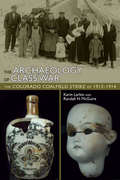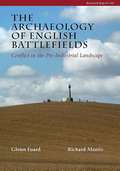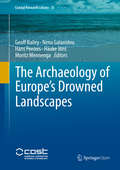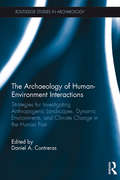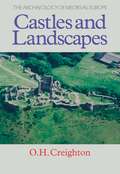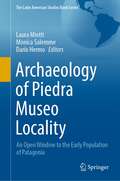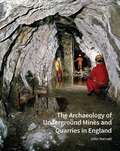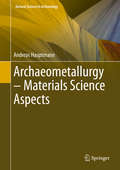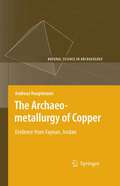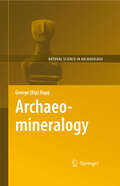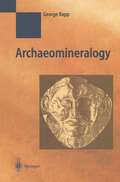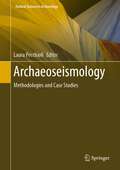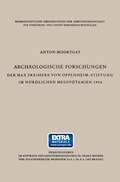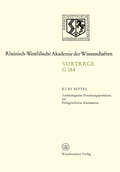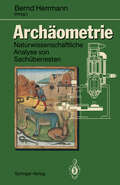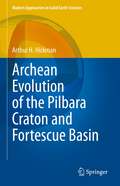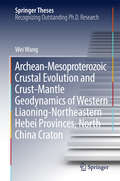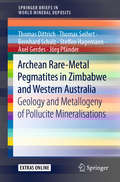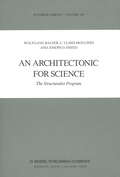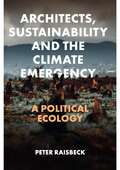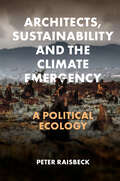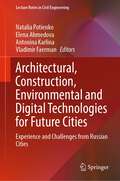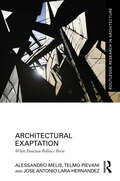- Table View
- List View
The Archaeology of Class War: The Colorado Coalfield Strike of 1913-1914
by Karin Larkin Randall H. McGuireThe Archaeology of the Colorado Coalfield War Project has conducted archaeological investigations at the site of the Ludlow Massacre in Ludlow, Colorado, since 1996. With the help of the United Mine Workers of America and funds from the Colorado State Historical Society and the Colorado Endowment for the Humanities, the scholars involved have integrated archaeological finds with archival evidence to show how the everyday experiences of miners and their families shaped the strike and its outcome.The Archaeology of Class War weaves together material culture, documents, oral histories, landscapes, and photographs to reveal aspects of the strike and life in early twentieth-century Colorado coalfields unlike any standard documentary history. Excavations at the site of the massacre and the nearby town of Berwind exposed tent platforms, latrines, trash dumps, and the cellars in which families huddled during the attack. Myriad artifacts—from canning jars to a doll’s head—reveal the details of daily existence and bring the community to life.The Archaeology of Class War will be of interest to archaeologists, historians, and general readers interested in mining and labor history.
The Archaeology of English Battlefields: conflict in the pre-industrial landscape (PDF) 400MB+ request by email
by Glenn Foard Richard MorrisThis volume presents the results of the first national assessment of English battlefields. The primary written sources are complemented by the results of extensive fieldwork, computer-based terrain reconstruction, and scientific analysis of artefacts recovered from battlefields. The authors proposed methodology for investigating battlefield locations is validated by the recent identification of the precise location of the Battle of Bosworth, some 3km from the traditional site.
The Archaeology of Europe’s Drowned Landscapes (Coastal Research Library #35)
by Geoff Bailey Nena Galanidou Hans Peeters Hauke Jöns Moritz MennengaThis open access volume provides for the first time a comprehensive description and scientific evaluation of underwater archaeological finds referring to human occupation of the continental shelf around the coastlines of Europe and the Mediterranean when sea levels were lower than present. These are the largest body of underwater finds worldwide, amounting to over 2500 find spots, ranging from individual stone tools to underwater villages with unique conditions of preservation. The material reviewed here ranges in date from the Lower Palaeolithic period to the Bronze Age and covers 20 countries bordering all the major marine basins from the Atlantic coasts of Ireland and Norway to the Black Sea, and from the western Baltic to the eastern Mediterranean. The finds from each country are presented in their archaeological context, with information on the history of discovery, conditions of preservation and visibility, their relationship to regional changes in sea-level and coastal geomorphology, and the institutional arrangements for their investigation and protection. Editorial introductions summarise the findings from each of the major marine basins. There is also a final section with extensive discussion of the historical background and the legal and regulatory frameworks that inform the management of the underwater cultural heritage and collaboration between offshore industries, archaeologists and government agencies. The volume is based on the work of COST Action TD0902 SPLASHCOS, a multi-disciplinary and multi-national research network supported by the EU-funded COST organisation (European Cooperation in Science and Technology). The primary readership is research and professional archaeologists, marine and Quaternary scientists, cultural-heritage managers, commercial and governmental organisations, policy makers, and all those with an interest in the sea floor of the continental shelf and the human impact of changes in climate, sea-level and coastal geomorphology.
The Archaeology of Human-Environment Interactions: Strategies for Investigating Anthropogenic Landscapes, Dynamic Environments, and Climate Change in the Human Past (Routledge Studies in Archaeology)
by Daniel ContrerasThe impacts of climate change on human societies, and the roles those societies themselves play in altering their environments, appear in headlines more and more as concern over modern global climate change intensifies. Increasingly, archaeologists and paleoenvironmental scientists are looking to evidence from the human past to shed light on the processes which link environmental and cultural change. Establishing clear contemporaneity and correlation, and then moving beyond correlation to causation, remains as much a theoretical task as a methodological one. This book addresses this challenge by exploring new approaches to human-environment dynamics and confronting the key task of constructing arguments that can link the two in concrete and detailed ways. The contributors include researchers working in a wide variety of regions and time periods, including Mesoamerica, Mongolia, East Africa, the Amazon Basin, and the Island Pacific, among others. Using methodological vignettes from their own research, the contributors explore diverse approaches to human-environment dynamics, illustrating the manifold nature of the subject and suggesting a wide variety of strategies for approaching it. This book will be of interest to researchers and scholars in Archaeology, Paleoenvironmental Science, Ecology, and Geology.
The Archaeology of Human-Environment Interactions: Strategies for Investigating Anthropogenic Landscapes, Dynamic Environments, and Climate Change in the Human Past (Routledge Studies in Archaeology)
by Daniel A. ContrerasThe impacts of climate change on human societies, and the roles those societies themselves play in altering their environments, appear in headlines more and more as concern over modern global climate change intensifies. Increasingly, archaeologists and paleoenvironmental scientists are looking to evidence from the human past to shed light on the processes which link environmental and cultural change. Establishing clear contemporaneity and correlation, and then moving beyond correlation to causation, remains as much a theoretical task as a methodological one. This book addresses this challenge by exploring new approaches to human-environment dynamics and confronting the key task of constructing arguments that can link the two in concrete and detailed ways. The contributors include researchers working in a wide variety of regions and time periods, including Mesoamerica, Mongolia, East Africa, the Amazon Basin, and the Island Pacific, among others. Using methodological vignettes from their own research, the contributors explore diverse approaches to human-environment dynamics, illustrating the manifold nature of the subject and suggesting a wide variety of strategies for approaching it. This book will be of interest to researchers and scholars in Archaeology, Paleoenvironmental Science, Ecology, and Geology.
The Archaeology of Medieval Europe: Castles and Landscapes
by O. H. CreightonCastles were among the most dominant features of the medieval landscape, and many remain impressive structures to the present day. This work looks at castles in a new light, using the theories and methods of landscape studies. Castles are examined not as an isolated phenomenon, but in relation to their surrounding human as well as physical areas. Taking a thematic approach, the study examines a broad range of evidence, archaeological, documentary and topographical, to assess the contribution of these structures on the evolution of the medieval landscape. The imprint of castles on the human landscape was powerful and often long-lived. As imposing icons of status and lordship, castles re-shaped the landscape in the minds of contemporaries, while as estate centres and manors they were closely connected with their surrounding hinterlands. The settlement landscape was also deeply affected by castle building as their powerful aristocratic owners fostered new towns and villages, while other communities were disrupted by their construction. The types of sites chosen for castles are also examined, as are the features that often accompanied them, including churches, mills, monasteries, deer parks, fishponds and gardens. Throughout, this book challenges many of our perceptions about medieval castles and presents some new avenues for future research. Alternative ISBNs 9781904768678
The Archaeology of Medieval Europe: Castles and Landscapes (PDF)
by O. H. CreightonCastles were among the most dominant features of the medieval landscape, and many remain impressive structures to the present day. This work looks at castles in a new light, using the theories and methods of landscape studies. Castles are examined not as an isolated phenomenon, but in relation to their surrounding human as well as physical areas. Taking a thematic approach, the study examines a broad range of evidence, archaeological, documentary and topographical, to assess the contribution of these structures on the evolution of the medieval landscape. The imprint of castles on the human landscape was powerful and often long-lived. As imposing icons of status and lordship, castles re-shaped the landscape in the minds of contemporaries, while as estate centres and manors they were closely connected with their surrounding hinterlands. The settlement landscape was also deeply affected by castle building as their powerful aristocratic owners fostered new towns and villages, while other communities were disrupted by their construction. The types of sites chosen for castles are also examined, as are the features that often accompanied them, including churches, mills, monasteries, deer parks, fishponds and gardens. Throughout, this book challenges many of our perceptions about medieval castles and presents some new avenues for future research. Alternative ISBN 9781904768678
Archaeology of Piedra Museo Locality: An Open Window to the Early Population of Patagonia (The Latin American Studies Book Series)
by Laura Miotti Monica Salemme Darío HermoThis book highlights the knowledge about landscapes and characteristics of the earliest hunter-gatherer lifeway in Southern Patagonia. It presents an analysis of the archaeological investigations carried out during three decades by an interdisciplinary team that involved archaeologists, anthropologists, paleontologists, geologists and specialists in pollen and diatoms. The database yielded was recovered from systematic survey and excavations from the Pleistocene and Holocene stratigraphic layers of the rockshelter known as AEP-1, Piedra Museo Locality, situated in the central plateau of Santa Cruz Province, Argentina. Piedra Museo is a unique place in the world of high academic interest with some of the earliest archaeological remains in the Americas. Researchers defined two strata and several Stratigraphic units in the site based on the sedimentological and pedological characteristics. The depositional zones contain archaeological remains that are interpreted as hunting events corresponding to two main different occasions in the human colonization of the region, and a third human occupation during the Middle Holocene. Last one occurred then of the massive rockshelter roof colapse. The faunal remains led to a new approach to the palaeoenvironmental evolution of this enclosed basin. This volume describes the management of lithic raw materials and social networks from first human occupation of the Patagonian region to territorial consolidation of hunter-gatherer societies.
The Archaeology of Underground Mines and Quarries (PDF)
by John BarnattThis book presents a detailed introduction to the underground mining and quarrying heritage in England.
Archaeometallurgy – Materials Science Aspects (Natural Science in Archaeology)
by Andreas HauptmannThis book successfully connects archaeology and archaeometallurgy with geoscience and metallurgy. It addresses topics concerning ore deposits, archaeological field evidence of early metal production, and basic chemical-physical principles, as well as experimental ethnographic works on a low handicraft base and artisanal metal production to help readers better understand what happened in antiquity. The book is chiefly intended for scholars and students engaged in interdisciplinary work.
The Archaeometallurgy of Copper: Evidence from Faynan, Jordan (Natural Science in Archaeology)
by Andreas HauptmannThe book deals with the ancient exploitation and production of copper, exemplified by the mining district of Faynan, Jordan. It is an interdisciplinary study that comprises (mining-) archaeological and scientific aspects. The development of organizational patterns and technological improvements of mining and smelting through the ages (5th millennium BC to Roman Byzantine period), in a specific mining region, is discussed.
Archaeomineralogy (Natural Science in Archaeology)
by George Rapp“Archaeomineralogy” provides a wealth of information for mineralogists, geologists and archaeologists involved in archaeometric studies. The first edition was very well-received and praised for its systematic description of the rocks and minerals used throughout the world by our ancestors and for its excellent list of over 900 references, providing easy access to the fields of archaeomineralogy and geoarchaeology.This second edition of “Archaeomineralogy” takes an updated and expanded look at the human use of rocks and minerals from the Paleolithic through to the 18th century CE. It retains the structure and main themes of the original but has been revised and expanded with more than 200 new references within the text, a bibliography of additional references not included in the text, a dozen new figures (drawings and photos), coverage of many additional important mineral, rock, and gem materials, a broader geographic scope, particularly but not limited to Eastern Europe, and a more thorough review of early contributions to archaeomineralogy, especially those of Agricola. From reviews of the first edition:"… crammed full of useful information, is well-balanced using both new and Old World examples of the archaeomaterials described. It also provides a broad, but of necessity, all too brief overview of the geological raw materials used in antiquity." -- Geoscientist "…provides much interesting discussion of how particular names came to be employed by archaeologists working in different regions of the world…. much to offer for any geologist or archaeologist interested in minerals and rocks and how they have been used in the past." -- Mineralium Deposita"… a gem of a book, it's strength is that it is encyclopedic in content, if not in layout, draws on a wealth of field experience and almost every sentence contains a nugget of information" -- The Holocene
Archaeomineralogy (Natural Science in Archaeology)
by George R. Rapp1.1 Prologue What is archaeomineralogy? The term has been used at least once before (Mitchell 1985), but this volume is the first publication to lay down the scientific basis and systematics for this subdiscipline. Students sometimes call an introductory archaeology course "stones and bones." Archaeomineralogy covers the stones component of this phrase. Of course, archaeology consists of a great deal more than just stones and bones. Contemporary archaeology is based on stratigraphy, geomorphology, chronometry, behavioral inferences, and a host of additional disciplines in addition to those devoted to stones and bones. To hazard a definition: archaeomineralogy is the study of the minerals and rocks used by ancient societies over space and time, as implements, orna ments, building materials, and raw materials for ceramics and other processed products. Archaeomineralogy also attempts to date, source, or otherwise char acterize an artifact or feature, or to interpret past depositional alteration of archaeological contexts. Unlike geoarchaeology, archaeomineralogy is not, and is not likely to become, a recognized subdiscipline. Practitioners of archaeomineralogy are mostly geoarchaeologists who specialize in geology and have a strong background in mineralogy or petrology (the study of the origin ofrocks).
Archaeoseismology: Methodologies and Case Studies (Natural Science in Archaeology)
by Laura PecchioliArchaeoseismic research provides data and information on past earthquakes but is limited by the lack of ongoing discussions about methodology. This volume is an interdisciplinary approach including archaeologists, geologists, geophysicists, seismologists, engineers, and architects from different countries to present a comprehensive recording and interpretation of ancient natural disasters on some case studies. The publication is an introduction to various aspects of the field of archaeoseismology for the knowledge of past seismicity, the reconstruction of the chronological history of a place, the interpretation and identification of seismic effects using different methods, etc. The collection provides an overview of research into archaeoseismology, making new contributions through innovative ideas on various topics. The publication can be an illustrative introduction to better understand the complexity of interpreting seismic effects on ancient and modern masonries, particularly for students with an open mind.
Archäologische Forschungen der Max Freiherr von Oppenheim-Stiftung im nördlichen Mesopotamien 1956 (Wissenschaftliche Abhandlungen der Arbeitsgemeinschaft für Forschung des Landes Nordrhein-Westfalen #7)
by Anton MoortgatArchäologische Forschungsprobleme zur Frühgeschichte Kleinasiens: 168. Sitzung am 23. Juni 1971 in Düsseldorf (Rheinisch-Westfälische Akademie der Wissenschaften #184)
by Kurt BittelArchäometrie: Naturwissenschaftliche Analyse von Sachüberresten
by Bernd HerrmannNaturwissenschaftliche Methoden sind heute unverzichtbarer Bestandteil umwelthistorischer und archäologischer Forschung und ermöglichen erst viele Befunde, auf die sich weiterreichende Aussagen gründen. Solche Aussagen und Zusammenhänge stehen im Mittelpunkt der Beiträge dieses Buches. Als Einführung wie als Begleitlektüre zum Praktikum gleichermaßen geeignet, stellt es klassische Methoden der Archäometrie, wie z.B. Datierungs- und Analyseverfahren, ebenso vor wie moderne Zugänge z.B. zu alter DNA oder die Auswertung anthropologischer, botanischer und zoologischer Befunde. Dieses Konzept schließt damit jene Lücke, welche bisher in der archäometrischen Darstellung biologischer Fundstücke bestand, und ist daher einer umweltgeschichtlichen Sichtweise besonders verpflichtet.
Archean Evolution of the Pilbara Craton and Fortescue Basin (Modern Approaches in Solid Earth Sciences #24)
by Arthur H. HickmanOne of today’s major geoscientific controversies centres on the origin of the Archean granite‒greenstone terranes. Is the geology of these scattered remnants of our planet’s early crust consistent with the theory that modern-style plate-tectonic processes operated from the early Archean, or does it indicate that tectonic and magmatic processes were different in the Archean? Earth has clearly evolved since its initial formation, so at what stage did its processes of crustal growth first resemble those of today? The logical place to seek answers to these intriguing and important questions is within the best-preserved early Archean crust. The Pilbara region of northwest Australia is internationally famous for its abundant and exceptionally well-preserved fossil evidence of early life. However, until recently the area has received much less recognition for the key evidence it provides on early Archean crustal evolution. This book presents and interprets this evidence through a new stage-by-stage account of the development of the Pilbara’s geological record between 3.53 and 2.63 Ga. The Archean Pilbara crust represents one fragment of Earth’s oldest known supercontinent Vaalbara, which also included the Kaapvaal Craton of southern Africa. Recognition of Vaalbara expands the background database for both these areas, allowing us to more fully understand each of them.
Archean-Mesoproterozoic Crustal Evolution and Crust-Mantle Geodynamics of Western Liaoning-Northeastern Hebei Provinces, North China Craton (Springer Theses)
by Wei WangThis thesis presents geological, petrological, geochemical, and zircon U–Pb–Lu–Hf isotopic field data for representative Precambrian lithologies in the Western Liaoning-Northeastern Hebei Provinces along the northern margin of the North China Craton (NCC). It describes late Neoarchean (2.64–2.48 Ga) supracrustal metavolcanic rocks and granitoid gneisses; late Paleoproterozoic (1.72–1.68 Ga) Jianping alkaline plutons and Pinggu alkaline volcanic rocks; and newly discovered ~1.23 Ga mafic dykes. The nature of magma sources and genesis of each magmatic episode are investigated, and the Precambrian (~2.6–1.2 Ga) lithospheric mantle evolution and crust-mantle interaction processes are established for the first time –aspects that provide important constraints in our understanding of the Precambrian crustal evolution and geodynamic processes in the region studied.
Archean Rare-Metal Pegmatites in Zimbabwe and Western Australia: Geology and Metallogeny of Pollucite Mineralisations (SpringerBriefs in World Mineral Deposits)
by Thomas Dittrich Thomas Seifert Bernhard Schulz Steffen Hagemann Axel Gerdes Jörg PfänderLithium-cesium-tantalum (LCT) pegmatites are important resources for rare metals. For Cs, only the LCT pegmatites with the zeolite group mineral pollucite at Bikita (Zimbabwe Craton) and Tanco (Superior Province Craton) are of commercial importance. Common characteristics of world-class LCT pegmatite deposits include their Meso- to Neoarchean age and geological setting within greenstone belt lithologies on Archean Cratons.This study presents the first coherent and comparative scientific investigation of five major LCT pegmatite systems from the Yilgarn, Pilbara and Zimbabwe Craton. For the evaluation of their Cs potential and of the genetic concepts of pollucite formation, the pegmatites from Wodgina, Londonderry, Mount Deans and Cattlin Creek were compared to the Bikita pollucite mineralization. The integration of the new data (e.g., geochronological and radiogenic isotope data) into the complex geological framework: 1) enhances our knowledge of the formation of LCT pegmatite systems, and 2) will contribute to the further exploration of additional world-class LCT pegmatite deposits, which 3) may host massive pollucite mineralisations.
An Architectonic for Science: The Structuralist Program (Synthese Library #186)
by W. Balzer C.U. Moulines J.D. SneedThis book has grown out of eight years of close collaboration among its authors. From the very beginning we decided that its content should come out as the result of a truly common effort. That is, we did not "distribute" parts of the text planned to each one of us. On the contrary, we made a point that each single paragraph be the product of a common reflection. Genuine team-work is not as usual in philosophy as it is in other academic disciplines. We think, however, that this is more due to the idiosyncrasy of philosophers than to the nature of their subject. Close collaboration with positive results is as rewarding as anything can be, but it may also prove to be quite difficult to implement. In our case, part of the difficulties came from purely geographic separation. This caused unsuspected delays in coordinating the work. But more than this, as time passed, the accumulation of particular results and ideas outran our ability to fit them into an organic unity. Different styles of exposition, different ways of formalization, different levels of complexity were simultaneously present in a voluminous manuscript that had become completely unmanageable. In particular, a portion of the text had been conceived in the language of category theory and employed ideas of a rather abstract nature, while another part was expounded in the more conventional set-theoretic style, stressing intui tivity and concreteness.
Architects, Sustainability and the Climate Emergency: A Political Ecology
by Peter RaisbeckThe promises, dreams and hopes of architects for future cities are now inextricably linked to climate change. Architects, Sustainability and the Climate Emergency: A Political Ecology chronicles how architects have shaped their ideas of the city—and sustainability—as knowledge of the climate emergency has unfolded. Have architects responded to the climate crisis too slowly? Describing a political ecology of architecture, Peter Raisbeck draws on architectural history, theory and practice, and the climate imaginaries of architects themselves. This exploration indicates how architects have viewed the climate emergency and positions architecture alongside the politics of climate and development studies. Raisbeck questions to what degree the traditional agency of architects leads to a political authority isolated from nature, human-environment systems and the nonhuman ecological subjects rapidly approaching tipping points. The fluidity of the climate emergency itself and its unfolding relationship to architectural knowledge suggests that new approaches, agencies and subjectivities are urgently required. As architects struggle to respond to the climate emergency, this book is an important and timely contribution to sustainability, climate and development debates. Architects, Sustainability and the Climate Emergency: A Political Ecology is a necessary provocation of a critical topic.
Architects, Sustainability and the Climate Emergency: A Political Ecology
by Peter RaisbeckThe promises, dreams and hopes of architects for future cities are now inextricably linked to climate change. Architects, Sustainability and the Climate Emergency: A Political Ecology chronicles how architects have shaped their ideas of the city—and sustainability—as knowledge of the climate emergency has unfolded. Have architects responded to the climate crisis too slowly? Describing a political ecology of architecture, Peter Raisbeck draws on architectural history, theory and practice, and the climate imaginaries of architects themselves. This exploration indicates how architects have viewed the climate emergency and positions architecture alongside the politics of climate and development studies. Raisbeck questions to what degree the traditional agency of architects leads to a political authority isolated from nature, human-environment systems and the nonhuman ecological subjects rapidly approaching tipping points. The fluidity of the climate emergency itself and its unfolding relationship to architectural knowledge suggests that new approaches, agencies and subjectivities are urgently required. As architects struggle to respond to the climate emergency, this book is an important and timely contribution to sustainability, climate and development debates. Architects, Sustainability and the Climate Emergency: A Political Ecology is a necessary provocation of a critical topic.
Architectural, Construction, Environmental and Digital Technologies for Future Cities: Experience and Challenges from Russian Cities (Lecture Notes in Civil Engineering #227)
by Vladimir Faerman Natalia Potienko Elena Ahmedova Antonina KarlinaThis book offers an overview of Russian and international experience in developing the concept of future cities and its practical implementation. The concept of future cities is associated with several important trends. The first trend is the sustainable development of the urban environment and the implementation of eco-friendly technologies and materials in civil construction, industrial and power plants. The harmonious coexistence of the citizens with all forms of nature in the urban habitat becomes a great value. The second trend is the individualization of the aesthetical and architectural image of the future cities. The city's unique flavor based on the blending of the historical legacy and architectural traditions is now as important as the utility of the environment. The third trend is the digitalization of the urban environment with the use of state-of-the-art sensors, information and communication technologies, and data science. The efficiency of operations and services achieved by the extensive use of complex IoT networks becomes a value as well. The last trend is the adaptation of the urban and social environment for individual demands of a community and a person. Individual comfort and safety are now more important than ever before. By addressing these trends, the volume discusses local and international plans, practices, and technologies aimed at the development and implementation of future cities.
Architectural Exaptation: When Function Follows Form (Routledge Research in Architecture)
by Alessandro Melis Telmo Pievani Jose Antonio Lara-HernandezArchitectural Exaptation: When Function Follows Form focuses on the significance and the originality of the study of exaptation. It presents exaptation as an opportunity to extend architectural design towards more sustainable approaches aimed at enforcing urban resilience.The use of exaptation’s definition in architecture supports the heuristic value of cross-disciplinary studies on biology and architecture, which seem even more relevant in times of global environmental crises. This book aims to make a critique of the pre-existing and extensive paternalistic literature. Exaptation will be described as a functional shift of a structure that already had a prior, but different, function. In architecture, a functional shift of a structure that already had a function may apply to forms of decorative elements embedded in architectural components, and to both change of function of tectonic elements and the change of use of an architectural space. The book is illustrated with examples from around the globe, including China, Italy, Mexico, New Zealand, the USA and the UK, and looks at different civilizations and diverse historical periods, ranging from the urban to the architectural scale. Such examples highlight the potential and latent human creative capacity to change the use and functions, something that cities and buildings could consider when facing disturbances. Exaptation is shown as an alternative narrative to the simplifications of evolutionary puritanism. It also offers an innovative perspective and presents an opportunity to re-think the manner in which we design and redesign our cities.This book will be of interest to architecture, planning, urban design and biology researchers and students.
